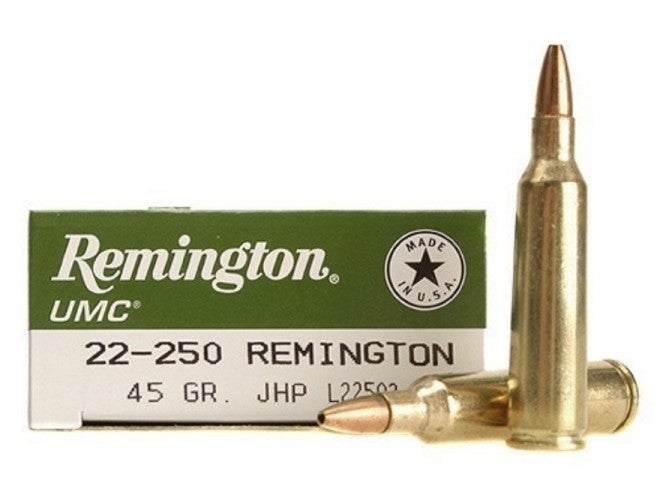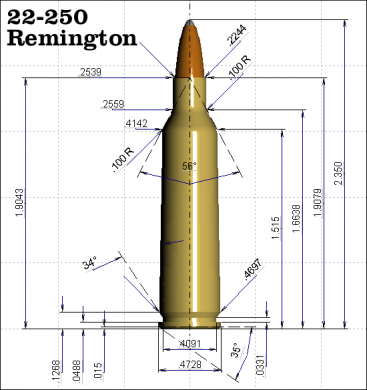Profile of a Cartridge: The 22-250 Remington
Russ Chastain 03.03.15

The 22-250 cartridge has a long and rich history with century-old roots, and the fact that it remains popular today bears witness to its fine design – and a bit of good fortune.
Way back in 1915, the 250 Savage made its appearance on the shooting scene. Designed by Charles Newton and introduced in the excellent Savage Model 99 lever-action rifle, the original cartridge used an 87-grain bullet driven at a whopping 3,000 FPS (feet per second). For that reason, Savage called it the 250-3000.
At that time, velocities of 2,000 FPS were impressive, and 3,000 was sort of mind-blowing.
Although modification of this new cartridge may have begun shortly after its introduction, we don’t know much about it until the 1930s, when certain ammunition experimenters known as “wildcatters” spent considerable time and effort fiddling with the 250 Savage. Those who “necked down” the brass case to accommodate a 22-caliber bullet developed the cartridge that would ultimately become known as the 22-250 Remington.
Between 1934 and 1937, different versions of 22-250 cartridges were worked on by the likes of Harvey Donaldson, Grosvenor Watkins, Jerry E. Gebby, J.B. Smith, and John Sweany.
Gebby and Smith teamed up, and their 1937 version is generally accepted to be the parent of today’s 22-250. They named it the 22 Varminter, and Gebby copyrighted that name – which probably doomed the name, because gunsmiths avoided copyright infringement by marking guns with the generic-but-safe “22-250” designation.
The 22-250 has faced many rivals over the past eight decades or so, and for the most part has come out on top as one of the most flexible and accurate small-bore cartridges around. One of the first comers was the 220 Swift, which was for decades the fastest commercial cartridge in the world. The 22-250 won out there, mainly because expectations and velocities were kept more reasonable, while the 220 Swift suffered from too much hype, along with some bad press.
Other early small-bore competition edged out by the 22-250 included the 22 Niedner Magnum, 22 Marciante Bluestreak, 22 Kilbourn Magnum, 22 Lindahl Chucker, 219 Improved Zipper, and the 219 Wasp. One of the main reasons was that it was easy to form 22-250 cases, whereas some of the others required a good bit of work just to modify a case to ready it for reloading.

The 22-250 rocked along for decades, quietly hanging on in spite of the lack of factory ammo, and in the early 1960s Browning offered bolt-action rifles chambered for it – but it was the 1965 introduction of 22-250 Remington 700 and 40XB rifles, and the adoption of the 22-250 as a standard cartridge with the Remington name appended, that finally gave it the validation it had deserved for so long.
For the record, Remington had absolutely nothing to do with the development of the 22-250, but by standardizing it and becoming the first to load it commercially, seized the opportunity to add its name to the cartridge.
Other gun manufacturers were quick to offer rifles chambered for 22-250 – and, as they say, the rest is history.
The 22-250 is an excellent target cartridge, and offers fine accuracy. It shines most as a long-range varmint cartridge, reaching out to 400 yards with enough oomph to erase large varmints at that range.
I must quote gun writer Ken Waters here, from a 1969 article he wrote about the 22-250:
If I were to buy a factory-made varmint rifle that would reach out to 400 yards, still retaining sufficient accuracy and killing power to dispatch large varmints, allow me to enter 200-yard bench rest or varmint rifle matches, drive heavier 60 and 63-grain bullets across the wind, and still offer excellent reduced-load capabilities, then I can’t think of a better round than the 22-250 Remington.
While the 22-250 is a great all-around cartridge, and there are always some folks who love to kill larger game with small-caliber bullets, I absolutely do not recommend it for hunting deer-sized or larger animals. The main reason is that factory-loaded 22-250 bullets are usually made to disintegrate quickly rather than penetrating, but my personal opinion is that even with bullets of heavier construction, 22 caliber is simply too small to offer a comfortable margin of error for hunters of medium and large game.
Many factory 22-250 loads are available today, with the slowest driving 60- and 64-grain bullets at 3500 FPS; lighter 40-grain bullets are driven at a whopping 4150 FPS. 50- and 55-grain slugs leave the muzzle at about 3600-3800 FPS. No wonder it’s known as a flexible cartridge.
One hundred years after the introduction of its parent cartridge and a half-century after its standardization, the 22-250’s popularity is far from waning. Savage Arms currently offers 26 models in that chambering, according to their website, and most other major rifle makers also offer 22-250 rifles.
I’ll wind up with a quote from Frank C. Barnes, from Cartridges of the World:
I would rate the 22-250 as the best all-round, long-range 22 varmint cartridge available today.
(Sources: Cartridges of the world, by Frank C. Barnes; Ken Waters’ Pet Loads, by Ken Waters; Ammo & Ballistics, by Bob Forker)